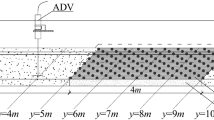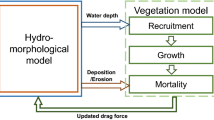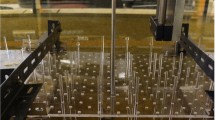Abstract
Riverbank erosion is a common natural river process that threatens the security of in-stream structures as well as public and private properties. The impacts of riparian vegetation on the riverbank erosion processes are still unclear. This study conducted flume experiments with artificial riverbanks and living vegetation to investigate the effects of riverbank vegetation conditions on the riverbank erosion process. Two riverbank types, nonvegetation and vegetation riverbanks, with three growth times of vegetation (T = 15, 30, and 60 d) were compared and discussed. The results show that the erosion form on vegetation riverbanks is the individual particles, whereas it is a large block of soil on nonvegetation riverbanks. The equilibrium channel width, riverbank erosion volume, and bed deposition of the vegetation riverbank are lower than those of the nonvegetation riverbank. As the vegetation growth time increases, the equilibrium channel width, riverbank erosion volume, and bed deposition volume decrease. The experimental data also indicate that the temporal channel width of the nonvegetation riverbank is greater than that of the vegetation riverbank; the lower the vegetation growth time, the greater the temporal channel width.
Highlights
This study was conducted by planting real vegetation on a riverbank.
Riparian vegetation can increase the stability of riverbanks because of mechanical, hydrological, and hydraulic effects.
The erosion form on vegetation riverbanks is the individual particles, whereas it is a large block of soil on nonvegetation riverbanks.









Similar content being viewed by others

Abbreviations
- H :
-
Riverbank height (cm)
- θ :
-
Riverbank slope angle (°)
- T :
-
Growth time of vegetation (day)
- D 50 :
-
Median diameter (mm)
- C u :
-
Non-uniformity coefficient
- Q :
-
Flow rate (L/s)
- H wo :
-
Initial channel water level (cm)
- S :
-
Initial riverbed slope
- ρ v :
-
Density of vegetation (stem/cm2)
- Lv :
-
Root length of vegetation (cm)
- C :
-
Cohesion (kPa)
- φ :
-
Internal friction angle (°)
References
Abam TKS (1993) Factors affecting distribution of instability of river banks in the Niger delta. Eng Geol 35(1): 123–133
Xia JQ, Zong QL, Deng SS, Xu QX, Lu JY (2014) Seasonal variations in composite riverbank stability in the Lower Jingjiang Reach, China. J Hydrol 519(2014): 3664–3673
Midgley TL, Fox GA, Heeren DM (2012) Evaluation of the bank stability and toe erosion model (BSTEM) for predicting lateral retreat on composite streambanks. Geomorphology 145(2012): 107–144
Grove JR, Croke J, Thompson C (2013) Quantifying different riverbank erosion processes during an extreme flood event. Earth Surf Proc Land 38(12): 1393–1406
Li Q, Wang L, Ma XD, Nie RH (2020) Experimental study of effects of riverbed composition on the riverbank erosion process. Proceedings of ICE - Water Management 173(4): 199–207
Casagli N, Rinaldi M, Gargini A, Curini A (1999) Pore water pressure and stream bank stability: results from a monitoring site on the Sieve River (Italy). Earth Surf Proc Land 24(12): 1095–1114
Millar RG (2000) Influence of bank vegetation on alluvial channel patterns. Water Resour Res 36(4): 1109–1118
Chu-Agor ML, Fox GA, Cancienne RM, Wilson GV (2008) Seepage caused tension failures and erosion undercutting of hillslopes. J Hydrol 359(4): 247–259
Yang KJ, Liu XN, Cao SY (2005) Turbulence characteristics of over bank flow in compound river channel with vegetated floodplain. J Hydraul Eng 36(10): 1263–1268
Ghani U, Anjum N, Pasha GA, Ahmad M (2019) Numerical investigation of the flow characteristics through discontinuous and layered vegetation patches of finite width in an open channel. Environ Fluid Mech 19(6): 1469–1495
Valyrakis M, Liu D, Turker U, Yagci O (2021) The role of increasing riverbank vegetation density on flow dynamics across an asymmetrical channel. Environ Fluid Mech 21(3) 643–666
Hopkinson L, Wynn T (2009) Vegetation impacts on near bank flow. Ecohydrology 2(4): 404–418
Simon A, Collison AJ (2010) Quantifying the mechanical and hydrologic effects of riparian vegetation on streambank stability. Earth Surf Proces Land 27(5): 527–546
Abernethy B, Rutherfurd ID (2000) The effect of riparian tree roots on the mass-stability of riverbanks. Earth Surf Proc Land 25(9): 921–937
Xu ZX, Ye C, Zhang YY, Wang XK, Yan XF (2020) 2D numerical analysis of the influence of near-bank vegetation patches on the bed morphological adjustment. Environ Fluid Mech 20(4): 707–738
Tang XN, Rahimi H, Guan Y, Wang Y (2021) Hydraulic characteristics of open-channel flow with partially-placed double layer rigid vegetation. Environ Fluid Mech 21(2): 317–342
Simon A, Collison AJ (2002) Quantifying the mechanical and hydrologic effects of riparian vegetation on streambank stability. Earth Surf Proc Land 27(5): 527–546
Krzeminska D, Kerkhof T, Skaalsveen K, Stolte J (2019) Effect of riparian vegetation on stream bank stability in small agricultural catchments. Catena 172(2019): 87–96
Simon A, Pollen N, Langendoen E (2006) Influence of two woody riparian species on critical conditions for streambank stability: Upper Truckee River, California 1[J]. Jawra J Am Water Resour Assoc 42(1): 99–113.
Tooth S, Nanson GC (2000) The role of vegetation in the formation of anabranching channels in an ephemeral river, Northern Plains, arid central Australia. Hydrol Process 14(16): 3099–3117
Kitsikoudis V, Yagci O, Kirca VO (2020) Experimental analysis of flow and turbulence in the wake of neighboring emergent vegetation patches with different densities. Environ Fluid Mech 20(6): 1417–1439
Huang HQ, Nanson GC (1997) Vegetation and channel variation; a case study of four small streams in southeastern Australia. Geomorphology 18(3): 237–249
López F, García M (1998) Open-channel flow through simulated vegetation: suspended sediment transport modeling[J]. Water Resour Res 34(9): 2341–2352.
Konsoer KM, Rhoads BL, Langendoen EJ, Best JL, Ursic ME, Abad JD, Garcia MH (2016) Spatial variability in bank resistance to erosion on a large meandering, mixed bedrock-alluvial river[J]. Geomorphology 252: 80–97.
Török GT, Parker G (2022) The influence of riparian woody vegetation on bankfull alluvial river morphodynamics[J]. Sci Rep 12(1): 1–15.
Tal M, Paola C (2010) Effects of vegetation on channel morphodynamics: results and insights from laboratory experiments. Earth Surf Proc Land 35(9): 1014–1028
Liu C, Nepf H (2016) Sediment deposition within and around a finite patch of model vegetation over a range of channel velocity. Water Resour Res 52(1): 600–612
Bennett SJ, Pirim T, Barkdoll BD (2002) Using simulated emergent vegetation to alter stream flow direction within a straight experimental channel. Geomorphology 44(1): 115–126
Van Dijk WM, Teske R, Van de Lageweg WI, Kleinhans MG (2013) Effects of vegetation distribution on experimental river channel dynamics. Water Resour Res 49(11): 7558–7574
Gyssels G, Poesen J, Bochet E, Li Y (2005) Impact of plant roots on the resistance of soils to erosion by water: a review[J]. Prog Phys Geog 29(2): 189–217.
Hickin EJ (1984) Vegetation and river channel dynamics[J]. Can Geogr 28(2): 111–126.
Operstein V, Frydman S (2000) The influence of vegetation on soil strength[J]. Proceedings of the Institution of Civil Engineers-Ground Improvement 4(2): 81–89.
De Baets S, Poesen J, Reubens B, Wemans K, De Baerdemaeker J, Muys B (2008) Root tensile strength and root distribution of typical Mediterranean plant species and their contribution to soil shear strength[J]. Plant and soil 305(1): 207–226.
Pollen-Bankhead N, Simon A (2010) Hydrologic and hydraulic effects of riparian root networks on streambank stability: is mechanical root-reinforcement the whole story?[J]. Geomorphology 116(3–4): 353–362.
Yu GA, Li ZW, Yang HY, Lu JY, Yi YJ (2020) Effects of riparian plant roots on the unconsolidated bank stability of meandering channels in the Tarim River, China. Geomorphology 351(2020): 106958
Acknowledgements
This work was supported by the National Natural Science Foundation of China [grant number U20A20319].
Funding
This work was supported by the National Natural Science Foundation of China [grant number U20A20319].
Author information
Authors and Affiliations
Contributions
All authors contributed to the study conception and design. Material preparation, testing, data collection and analysis were performed by Qiang Li, Lu Wang, Xudong Ma and Ruihua Nie. The first draft of the manuscript was written by Qiang Li and all authors commented on previous versions of the manuscript. All authors read and approved the final manuscript.
Corresponding author
Ethics declarations
Competing interests
The authors have no competing interests to declare that are relevant to the content of this article.
Additional information
Publisher’s Note
Springer Nature remains neutral with regard to jurisdictional claims in published maps and institutional affiliations.
Rights and permissions
Springer Nature or its licensor (e.g. a society or other partner) holds exclusive rights to this article under a publishing agreement with the author(s) or other rightsholder(s); author self-archiving of the accepted manuscript version of this article is solely governed by the terms of such publishing agreement and applicable law.
About this article
Cite this article
Li, Q., Wang, L., Ma, X. et al. Experimental study of the effects of riverbank vegetation conditions on riverbank erosion processes. Environ Fluid Mech 23, 621–632 (2023). https://doi.org/10.1007/s10652-023-09924-2
Received:
Accepted:
Published:
Issue Date:
DOI: https://doi.org/10.1007/s10652-023-09924-2



